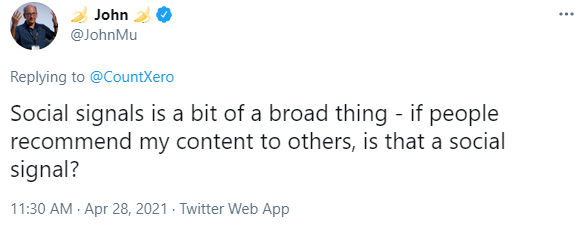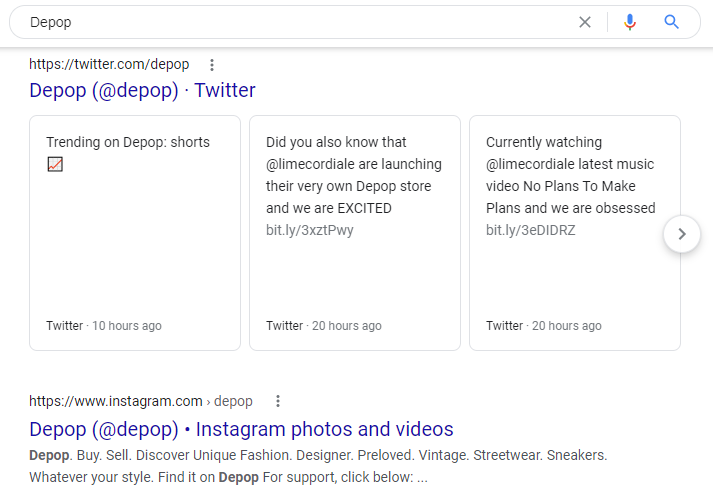Is there a link between SEO and social media?
Depends on who you ask.
Regardless, businesses today are eager to stand out in the search engine results pages (SERPs) and social space alike.
And just like you can’t ignore social media these days, the same rings true for SEO.
That’s because both channels are absolutely critical when it comes to product discovery, research and helping people make purchasing decisions. Rather than treating these marketing channels as a matter of either-or, it makes perfect sense to find common threads between them.
In this guide, we’ll highlight the basics of SEO and social media, including low-hanging ways to boost your social media efforts via SEO (and vice versa).
What is the connection between SEO and social media?
Fair question! Whether or not social media links and shares have a significant impact on SEO has been hotly debated for over a decade now.
Some SEO experts will tell you outright that Google doesn’t really take social media into account when it comes to rankings.

Conventional wisdom says that the correlation between SEO and social media is a gray area. If social links and shares are a ranking factor, they’re likely a relatively minor one.
Even so, the concept of social signals and their relation to Google rankings are still being discussed in 2021.

No matter where you stand, there’s no denying the connection between SEO and social media when it comes to increasing your brand’s visibility in search engines.
Below is a brief breakdown of how social media impacts search traffic, for starters:
Social media profiles consistently rank among top search results
Particularly for branded keywords, social media profiles are often front-and-center and immediately following any given brands’ website result.
For example, a Google search for “Depop” displays their Twitter and Instagram profiles under their site’s top spot. This result also includes previews of the brand’s most recent Tweets, further highlighting a relationship between SEO and social media when it comes to Google’s page-one content.

Meanwhile, Facebook represents a potential SEO goldmine for local businesses as it serves as an aggregator of positive reviews and potential bookings.

Google Analytics highlights social media as a significant traffic source
While this is arguably done for the sake of organization, the fact that social traffic is treated as its own entity is telling.
In short, you can learn about your social media efforts, target audience and search optimization alike in Google Analytics. This includes:
- Does social traffic engage better (or worse) than traffic from other channels?
- How does your volume of social traffic compare to organic, email, etc.?
- Which pieces of content shared via social drive the most traffic?

Social media links serve as a traffic funnel
Although concepts like social sites passing on “link juice” have been debunked, consider the potential snowball effect of increased social shares resulting in more traffic.
Do social shares have a significant effect in the SERPs? Perhaps not. Even so, social profiles themselves to individual pieces of content can be a significant driver of new visitors.

Brands that are active on social have the potential to build more backlinks either actively or passively. Consistently publishing content means more visibility and that visibility can result in links or relationships with people that might link to you down the road.
And if nothing else, your social activity is a potential treasure trove of information to influence your on-site content strategy as you understand what your audience wants to read, share and engage with.
How to optimize your social profiles for SEO
Let’s be clear here: we’re not talking about keyword stuffing or so-called “hacks.”
Instead, we’re going to focus on actionable optimization that’ll increase your social profiles’ visibility in the SERPs. The good news is that doing so doesn’t mean overhauling your presence or making any major changes. Here are some of the basics of social media SEO:
Fill out your social profiles with as many details as possible
No huge surprises here.
Some platforms have much more real estate than others for you to fill in your details (think: Facebook’s generous “About” section(s) versus a minimalist Instagram’s bio).
Either way, don’t let these spaces go to waste. Making a point to include industry keywords, location information and a link to your site.

Integrate keywords into your profile(s) and posts
Speaking of keywords, consider that social media at large is becoming more and more search-oriented.
Look no further than Instagram’s recently updated keyword search as evidence of this.

Performing keyword research is a good idea just for the sake of finding potential topics to post about and likewise optimizing your content for visibility. You don’t have to (nor should you) optimize every single caption or description that you write.
However, there are plenty of opportunities to integrate keywords into your posts naturally if you’re aware of them. This is especially true on platforms like LinkedIn or Pinterest where you have plenty of characters to work with.

Point links back to your site
Chances are you’re probably doing this already.
Although your own links shouldn’t be the sole source of your social content, they should definitely factor in if you’re hungry for more traffic.
From blog posts and promotions to downloadables and beyond, make sure you’re taking advantage of link tracking to assess what’s getting the most clicks and how visitors behave once they’re on-site. Doing so also clues you in at a glance at what your most popular links are via social. Here’s what the process looks like through Sprout Social’s URL shortener:

Share on-site content and encourage others to do the same
Getting a significant number of shares, particularly to the point where you could build a buzz for links or traffic, means scoring beyond your own account.
Perhaps one of the most effective ways to make this happen is through employee advocacy. Now a staple of B2B social media, encouraging colleagues and coworkers to share content is a much more measurable and scalable way to increase visibility versus hoping your audience makes it happen. The team as G2 does a brilliant job of this.
When it comes to your SaaS budget, it would be nice to have a crystal ball to let you know what to expect in the new year. That may not be realistic, but G2 Track the next best thing for SaaS forecasting. https://t.co/6ryZ491KMF
— mara ?? (@mara_calv) December 14, 2020
Publish content that’s worthy of backlinks
Posting linkable assets on social media is a no-brainer, but which sorts of post are prime for links?
When in doubt, infographics and original reports are safe bets. These posts are typically among the highest-performing on social since they’re presented as “breaking news” and are easy to digest. Likewise, original research often represents a primary source that hasn’t been linked elsewhere.
Fact: Fewer people are using hashtags for social discovery. Find out where consumers are turning their attention instead in this year's Sprout Social Index. https://t.co/YuWeXmiWBk pic.twitter.com/rcdzFDJNpx
— Sprout Social (@SproutSocial) May 18, 2020
4 quick social media tips to support your SEO efforts
To wrap things up, let’s look at some other tactics that combine SEO and social to get more out of your investment in both channels.
Make your on-site content easy to share
Social sharing buttons are staples of blogs these days. Quick-copy links and single-click sharing should be integrated into your site in some way, shape or form.
Bonus points if you don’t have to make your readers dig for your sharing buttons. Below is a good example from Grammarly, showcasing social share buttons that follow visitors as they scroll through a post.

Translate your social data into content ideas
If you’re strapped for fresh content ideas, look no further than your social feed.
From potential blog topics to the latest trends and keywords you need to stay on top of it, there’s arguably no better place than social media to find them. After social, social conversations are timely and you can assess trends instantly rather than wait for traffic to roll in to figure them out.
This is where a tool like Sprout really comes in handy. Through our platform’s social listening features, you can quickly hone in on topics and trends without having to do a bunch of guesswork. Social listening is also a useful tool for making sure that your marketing messaging is landing and you’re speaking your audience’s language.

Fine-tune your publishing frequency
Establishing a consistent content calendar is going to produce better results trafficwise than posting at random.
Familiarize yourself with the best times to post on social media and make sure that links to your site are part of your content strategy. As a side note, don’t be afraid to publish and recycle links to blog posts. Given the legwork required to put together any given post, they deserve to be shared multiple times. If you don’t want to repeat yourself, consider repurposing your content for the sake of social sharing.
Foster relationships with your audience and potential link-builders
We’re all about relationship-building here at Sprout. Building an engaged community means that you’re more likely to score clicks and attract meaningful traffic to your site. Those same folks can also give your content a much-needed boost when prompted.
You can likewise use social media as an active avenue for link building. We’re not talking about soliciting for links, but rather participating in conversations with others in your industry. For example, it’s common for bloggers to connect and share content on Twitter and use each other’s posts in newsletters, social feeds and so on.
Do you have a strategy for SEO and social media?
Whether search or social is your primary focus, consider how both channels absolutely compliment each other.
Doing so means getting more out of your marketing efforts. Likewise, you can uncover a ton of customer insights and content ideas in the process.
If you haven’t already, make sure to check out our guide to social marketing that breaks down even more ideas for creating top-tier content and growing an audience.
The post SEO and social media: How to use search to boost your social marketing appeared first on Sprout Social.